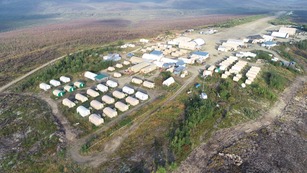
In Alaska, operators of large metal mines are required to reclaim and close their mines. They cannot even begin construction of the mine until the state has approved their plans, and they have put up money – called financial assurance – that the state could use if the company fails to complete the job.
Financial assurance provides money that the state can use to completely reclaim and close the mine if the company fails to do so. The money is insurance for Alaska and its citizens that, if something happens to the company, the mine will be closed and the land reclaimed without the use of taxpayer dollars. Mining is the only industry in Alaska that has these requirements.
Required Financial Assurance
The Alaska Department of Natural Resources (DNR), and the Alaska Department of Environmental Conservation (DEC) oversee metal mining operations. State engineers review the company’s calculations to ensure there is enough money for the state to close the mine if necessary. The amount of the financial assurance must also include the cost to monitor the site for 30 years after the mine finishes closure. This post-closure monitoring is to assure Alaskans that not only is the mine closed, but that the closure is working properly.
The plan and the amount of financial assurance are reviewed every five years as part of the permit renewal process or whenever there is a significant change in operation plans or anticipated costs. In addition, the state hires (and the mine pays for) a third party company – neither the state nor the mining company – to check the state and the company’s financial assurance calculations and verify that the amount is adequate.
Financial assurance applies to every company mining in Alaska, including those based in another state or country. The amounts range from tens of millions to hundreds of millions of dollars depending on the size of the mine, location, and other unique characteristics.
How Does Financial Assurance For A Mining Operation Work?
A variety of instruments are acceptable for financial assurance: money in a bank deposit, bank guarantee, and other forms. But they all have one thing in common: the state can use it to pay contractors to close the mine if the mining company cannot. However, it is in the company’s best interest to undertake reclamation and closure itself while they have the equipment and personnel on site.
.jpg)
How Are The Amounts Determined?
The amount is calculated based on the required reclamation and closure activities, including soil stabilization, erosion control, water treatment, removal of all site facilities, habitat restoration, and post-closure monitoring. The amount may also include allowances for long-term water treatment if necessary.
Current financial assurance of Alaska’s large operating metal mines:
- Donlin Gold Project (not yet in operation) - $322 Million
- Hecla Greens Creek Mine - $92 Million
- Red Dog Mine - $563 Million
- Fort Knox Mine - $99 Million
- Kensington Mine - $29 Million
- Pogo Mine - $72 Million
(Source: Alaska Department of Natural Resources Office of Project Management and Permitting.)
Administration And Monitoring
Throughout the construction and operation of the mine, the state monitors the mining site to ensure compliance with regulatory requirements as well as evaluating whether any changes to operations require new financial assurance calculations. If the operator fails to meet the state’s reclamation requirements, the financial assurance can be used to fund reclamation efforts carried out by the state or a designated third party.
Alaska Responsibly Develops Its Natural Resources
Overall, financial assurance for mining in Alaska is designed to protect the environment and ensure that mining activities are conducted responsibly and sustainably, without a cost to Alaska’s citizens.
Find out more from DNR about the reclamation and closure of an Alaska mine: True North.
Starting in 2009, the operators’ work included grading and recontouring 149 acres, seeding and fertilizing 270 acres, planting vegetation on 52 acres, and removing all mining buildings. By 2014, the site was essentially fully revegetated, but the state required several years of monitoring to ensure long-term stability of the landscape. In 2020, the state announced that the operators had completed reclamation – the site had approved landforms, adequate vegetation, and caused no water or air pollution.
Resources:
https://dnr.alaska.gov/mlw/mining/reclamation/true-north/
Banner image courtesy of NOVAGOLD, Donlin Gold Project


.jpg)
%20(1).jpg)


